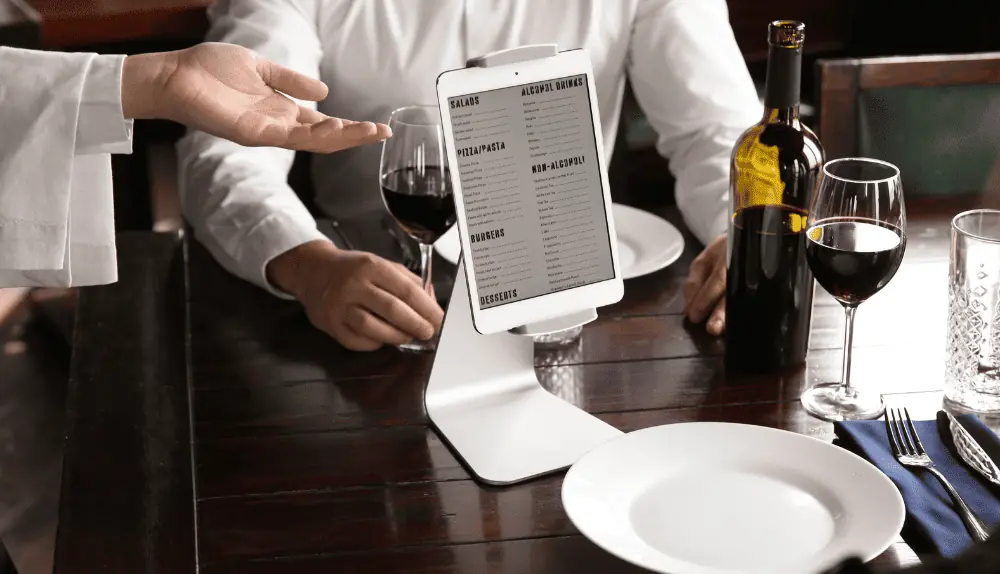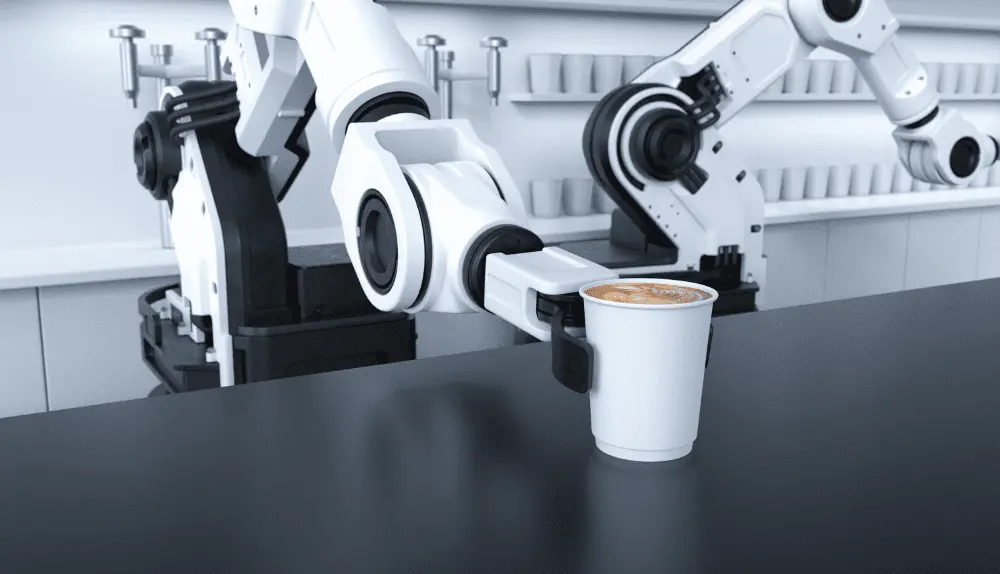In a world where culinary excellence meets cutting-edge innovation, the success of restaurants is no longer solely determined by mouthwatering dishes and impeccable service. A new player has entered the dining scene, revolutionizing the way we experience gastronomy: technology. From smart ordering systems to virtual reality dining experiences, restaurants are embracing technological trends like never before, redefining the very essence of the dining experience. In this era of unprecedented connectivity and digital transformation, the intertwining of technology and hospitality has become the secret recipe for restaurant success.
Join us on a journey through the ever-evolving landscape of the dining industry, where we explore how restaurant success is becoming increasingly dependent on technology trends. Get ready to embark on a captivating exploration where pixels meet palates, and the fusion of technology and culinary artistry is rewriting the recipe for restaurant success.
How is Technology Helping Businesses?

In today’s dynamic and fast-paced world, the success of restaurants is increasingly dependent on their ability to adapt to the latest technological trends. From the moment a customer walks through the door to the final bite of a delectable dessert, technology is reshaping every aspect of the dining experience. With advancements in digital innovation, restaurants now have access to a wide array of tools and solutions that streamline operations, expand their reach, personalize customer interactions, amplify their online presence, and enhance the overall dining experience. In this era of unprecedented connectivity and digital transformation, embracing technology has become an essential ingredient for achieving remarkable success in the competitive restaurant industry.
Streamlining Operations: Enhancing Efficiency and Accuracy
In an industry where time is of the essence, technology has emerged as a game-changer by streamlining various restaurant operations. From advanced point-of-sale (POS) systems that automate order-taking and payment processing to inventory management software that optimizes stock levels and tracks ingredient usage, restaurants are leveraging technology to enhance efficiency and accuracy. By automating mundane tasks, staff can focus on providing exceptional customer service and maintaining the highest culinary standards.
Online Ordering and Delivery: Expanding Reach and Convenience
The rise of technology has paved the way for the exponential growth of online ordering and food delivery services. With the proliferation of user-friendly mobile apps and websites, customers can now browse menus, place orders, and arrange doorstep delivery with just a few taps on their smartphones. This convenience not only caters to the ever-increasing demand for hassle-free dining experiences but also allows restaurants to expand their customer base beyond physical locations. By partnering with third-party delivery platforms, eateries can reach a wider audience and boost their revenue streams.
Personalized Customer Experiences: Tailoring to Individual Tastes
Technology has ushered in a new era of personalized dining experiences, catering to the diverse tastes and preferences of customers. Through sophisticated customer relationship management (CRM) systems, restaurants can gather valuable data about their patrons, including dining preferences, dietary restrictions, and past orders. Armed with this information, establishments can offer customized recommendations, personalized promotions, and even tailor menus to suit individual tastes. By leveraging technology, restaurants can create memorable experiences that resonate with their customers and foster loyalty.
Social Media and Online Marketing: Amplifying Visibility and Engagement
In today’s digital age, social media platforms have become indispensable tools for restaurant marketing. From Instagram-worthy food photos to interactive promotions, restaurants are utilizing social media channels to showcase their culinary creations, engage with customers, and build brand awareness. Moreover, online review platforms and rating systems provide valuable feedback, enabling restaurants to refine their offerings and improve customer satisfaction. By harnessing the power of social media and online marketing, restaurants can amplify their visibility, attract new customers, and cultivate a vibrant online community.
Enhancing the Dining Experience: Immersive Technology Innovations
Advancements in technology have given rise to immersive dining experiences that blend virtual reality (VR), augmented reality (AR), and interactive elements. From VR simulations that transport diners to exotic locations to AR menus that display detailed information about dishes, these innovations add an extra layer of excitement and engagement to the dining process. Additionally, digital tabletop devices and self-service kiosks empower customers to customize their orders and make real-time modifications, providing them with greater control and enhancing their overall dining experience.
Overall, technology is revolutionizing the restaurant industry by streamlining operations, expanding reach through online ordering and delivery, personalizing customer experiences, amplifying visibility through social media and online marketing, and enhancing the dining experience through immersive innovations. As restaurants embrace these technological trends, they gain a competitive edge, attracting customers, improving efficiency, and ultimately paving the way for success in the evolving culinary landscape.
Restaurant Success Dependent On Technology Trends

The restaurant industry is constantly evolving, and several technology trends are currently shaping its landscape. Here are some of the latest technology trends in the restaurant industry:
Contactless Ordering and Payment
With the ongoing focus on hygiene and safety, contactless ordering and payment solutions have gained significant popularity. Mobile apps, QR codes, and self-service kiosks allow customers to browse menus, place orders, and make payments without physical contact, minimizing the need for traditional menus and cash transactions.
Delivery Management Platforms
As online food delivery continues to surge, delivery management platforms are becoming increasingly important for restaurants. These platforms streamline the entire delivery process, from order placement to tracking and real-time updates, ensuring efficient and seamless delivery operations.
AI-Powered Automation
Artificial Intelligence (AI) is being utilized to automate various aspects of restaurant operations. AI-powered chatbots and virtual assistants can handle customer inquiries, reservation bookings and provide personalized recommendations. Automated inventory management systems leverage AI to optimize stock levels, reduce waste, and improve supply chain efficiency.
Data Analytics and Insights
Restaurants are harnessing the power of data analytics to gain valuable insights into customer behavior, preferences, and operational performance. By analyzing customer data, restaurants can make data-driven decisions regarding menu optimization, marketing campaigns, and staffing requirements, leading to improved customer experiences and increased profitability.
Online Reputation Management
With the prevalence of online review platforms and social media, managing a restaurant’s online reputation has become crucial. Restaurants are employing technology tools to monitor and respond to online reviews, engage with customers on social media, and actively manage their brand image to enhance customer satisfaction and loyalty.
Augmented Reality (AR) and Virtual Reality (VR) Experiences
AR and VR technologies are being used to create immersive dining experiences. Restaurants are exploring virtual reality dining simulations, where customers can virtually visit farms or experience unique environments while enjoying their meals. Augmented reality menus provide interactive elements such as 3D visuals or detailed information about dishes when viewed through mobile devices.
Smart Kitchen Technology
Restaurants are adopting smart kitchen technology to enhance operational efficiency and food quality. IoT-enabled devices and sensors monitor equipment performance, automate temperature control, and track cooking processes, ensuring consistency and reducing the risk of errors.
Sustainability and Waste Reduction Solutions
Technology is being leveraged to address sustainability challenges in the restaurant industry. From smart waste management systems that track and optimize waste disposal to apps that connect restaurants with surplus food to food banks, technology is aiding in reducing food waste and promoting sustainable practices.
These are just a few of the latest technology trends making an impact in the restaurant industry. Embracing these innovations allows restaurants to stay ahead of the curve, enhance customer experiences, and improve overall operational efficiency.
Benefits of Technology in the Restaurant Industry

Technology brings many benefits to restaurants, revolutionizing operations and enhancing the overall dining experience. Here are some key benefits of technology in restaurants:
Increased Efficiency
Technology streamlines various restaurant operations, automating manual tasks and improving efficiency. From advanced POS systems that speed up order processing to automated inventory management software that optimizes stock levels, technology allows restaurants to operate more smoothly and serve customers faster.
Enhanced Customer Service
Technology enables restaurants to provide exceptional customer service. With features like self-service kiosks and online ordering systems, customers have more control over their dining experience, customizing their orders and making real-time modifications. Additionally, technology tools like CRM systems allow restaurants to gather customer data, enabling personalized recommendations and promotions.
Expanded Reach
Online ordering and food delivery platforms have significantly expanded the reach of restaurants. Through mobile apps and websites, restaurants can cater to a wider audience beyond their physical locations. By partnering with third-party delivery services, restaurants can reach new customers and increase revenue streams.
Improved Accuracy and Order Management
Technology reduces errors and improves order accuracy. With digital ordering systems, customers can place their orders directly, minimizing miscommunications. Integrated POS systems ensure seamless communication between front-of-house and kitchen staff, reducing order mistakes and enhancing overall order management.
Data-Driven Insights
Technology provides valuable data and insights for restaurants to make informed decisions. Data analytics tools help restaurants understand customer preferences, identify trends, and optimize menu offerings. This data-driven approach allows restaurants to better cater to their customers’ needs and preferences, leading to increased customer satisfaction.
Enhanced Marketing and Branding
Technology tools such as social media platforms and online review management systems help restaurants build their brand image and engage with customers. Restaurants can showcase their offerings through visually appealing content and actively respond to customer reviews and feedback. This strengthens brand loyalty and attracts new customers.
Improved Inventory Management
Technology aids in efficient inventory management, reducing waste, and optimizing costs. By tracking ingredient usage and automating replenishment processes, restaurants can minimize food waste, ensure freshness, and control inventory levels effectively.
Innovation and Differentiation
Technology opens up avenues for innovation and differentiation in the restaurant industry. Virtual reality dining experiences, interactive menus, and unique digital marketing campaigns help restaurants stand out from the competition and provide memorable experiences to customers.
Overall, technology in restaurants offers numerous benefits, including increased efficiency, enhanced customer service, expanded reach, improved accuracy and order management, data-driven insights, enhanced marketing and branding, improved inventory management, and opportunities for innovation and differentiation. Embracing technology empowers restaurants to thrive in the modern dining landscape and meet the evolving expectations of customers.
Is Automation Good for Restaurant Business?

Automation can be highly beneficial for the restaurant business. Here are some reasons why automation is considered advantageous:
Improved Efficiency
Automation streamlines repetitive tasks and eliminates manual errors, leading to improved operational efficiency. Automated systems can handle order taking, payment processing, inventory management, and other routine tasks, freeing up staff to focus on providing excellent customer service and enhancing the overall dining experience.
Cost Savings
By automating certain processes, restaurants can reduce labor costs and minimize errors that may result in financial losses. For example, automated inventory management systems can help optimize stock levels, reduce waste, and prevent overstocking or stockouts. Automation can also lead to increased productivity, allowing restaurants to do more with fewer staff members.
Enhanced Accuracy
Automated systems reduce the chances of human error, ensuring more accurate order processing, inventory tracking, and financial calculations. This results in improved customer satisfaction, as customers receive their orders correctly and are less likely to encounter issues with billing or inventory discrepancies.
Faster Service
Automation speeds up various aspects of restaurant operations. With automated order taking and payment processing, orders can be processed more quickly, reducing waiting times for customers. Additionally, automated kitchen display systems can improve communication between the front-of-house and back-of-house staff, leading to faster food preparation and delivery.
Consistency in Quality
Automation helps maintain consistency in food preparation and quality. Automated cooking equipment can ensure precise cooking times and temperatures, reducing variations in taste and texture. This consistency contributes to a positive dining experience, as customers know they can expect the same quality each time they visit.
Data-Driven Insights
Automated systems generate data that provides valuable insights into customer preferences, sales patterns, and operational performance. By analyzing this data, restaurants can make informed decisions about menu offerings, marketing strategies, and overall business planning. Data-driven insights help optimize operations and tailor offerings to meet customer demands, leading to increased customer satisfaction and revenue.
Adaptability and Scalability
Automation allows restaurants to adapt to changing business needs and scale their operations more efficiently. As customer demand fluctuates, automated systems can quickly adjust inventory levels, staffing requirements, and order processing to meet changing demands. This adaptability enables restaurants to respond effectively to market dynamics and grow their business.
While automation offers numerous benefits, it’s important to strike a balance between automation and maintaining a human touch in the dining experience. Finding the right mix of technology and personalized service is key to leveraging the advantages of automation while preserving the unique atmosphere and hospitality that restaurants offer.
How to Implement Technology Trends in Your Restaurant?
Adopting technology trends in your restaurant requires careful planning and implementation. Here are steps to effectively adopt technology trends in your restaurant:
Identify Your Needs and Goals
Evaluate your restaurant’s specific needs and goals. Determine which areas of your operations can benefit from technology, such as online ordering, inventory management, customer engagement, or kitchen automation. Understanding your objectives will help you select the most appropriate technology solutions.
Research and Explore Technology Options
Conduct thorough research on available technology solutions that align with your needs and goals. Look for reputable vendors, read reviews, and compare features, pricing, and compatibility. Attend industry conferences, trade shows, and webinars to stay informed about the latest technology trends and innovations.
Plan Your Budget
Determine the budget you can allocate for adopting technology. Consider upfront costs, ongoing expenses, and potential return on investment. It’s essential to strike a balance between your budget, and the long-term benefits technology can bring to your restaurant.
Prioritize and Phase Implementation
Prioritize the technology solutions you want to adopt based on their potential impact on your operations. It’s often beneficial to phase the implementation process to ensure smooth integration and minimize disruptions. Start with solutions that have a significant impact or address critical pain points, and gradually introduce additional technologies over time.
Involve Your Staff
Engage your staff in the adoption process to gain their support and participation. Provide training and support for employees to familiarize themselves with new technology systems. Encourage their feedback and address any concerns they may have, as their buy-in is crucial for successful implementation.
Test and Pilot
Before implementing technology solutions on a large scale, conduct thorough testing and piloting. Choose a smaller segment of your operations or a specific time period to test the technology’s functionality, compatibility, and impact. Gather feedback from staff and customers during this pilot phase to make any necessary adjustments.
Integrate Systems and Processes
Ensure smooth integration of the new technology with your existing systems and processes. If necessary, work with technology vendors or consultants to integrate the systems seamlessly. This may involve data migration, system configuration, and process adjustments to optimize efficiency and eliminate any duplication or redundancy.
Monitor and Evaluate Performance
Continuously monitor and evaluate the performance of the implemented technology solutions. Track key metrics, such as customer satisfaction, order processing time, inventory accuracy, and revenue growth. Regularly assess the impact of technology on your operations and make adjustments as needed.
Stay Updated and Evolve
Technology trends evolve rapidly, so it’s essential to stay updated on emerging technologies and industry best practices. Attend industry events, engage with technology vendors, and network with other restaurant owners and operators. Continuously assess new opportunities and be open to adopting additional technologies that can further enhance your restaurant’s operations and customer experience.
Remember, technology adoption is an ongoing process. Embrace a mindset of continuous improvement and adaptability, and be willing to explore and adopt new technologies as they emerge to stay ahead in the ever-evolving restaurant industry.
Final Words
The restaurant industry is experiencing a profound transformation driven by technology. From streamlining operations and enhancing efficiency to improving customer experiences and expanding reach, technology is reshaping every aspect of the dining landscape. By embracing automation, online ordering, data analytics, and other technological advancements, restaurants can optimize their operations, reduce costs, and stay competitive in a rapidly evolving market.
However, it is important to strike a balance between technology and maintaining a human touch to preserve the unique atmosphere and hospitality that restaurants offer. The successful adoption of technology trends requires careful planning, involvement of staff, and continuous monitoring and evaluation. As the restaurant industry continues to evolve, staying informed about the latest technology trends and embracing innovation will be crucial for restaurants to thrive and deliver exceptional dining experiences in the digital age.
Frequently Asked Questions (FAQs)
How can technology improve the efficiency of restaurant operations?
Technology can improve efficiency by automating processes such as order taking, payment processing, inventory management, and kitchen operations. It reduces manual errors, speeds up service, and optimizes resource allocation.
How can technology help in managing inventory effectively?
Technology provides inventory management systems that automate inventory tracking, optimize stock levels, and reduce waste. It helps in monitoring ingredient usage, predicting demand, and minimizing overstocking or stockouts.
What role does data analytics play in the restaurant industry?
Data analytics helps restaurants gain insights into customer behavior, preferences, and operational performance. It enables data-driven decision-making, personalized customer experiences, targeted marketing campaigns, and menu optimization.
What considerations should be made when adopting new technology in a restaurant?
Considerations include identifying specific needs and goals, researching available technology options, planning a budget, involving staff, conducting testing and piloting, integrating systems, and continuously monitoring performance.
How can technology enhance the customer experience in restaurants?
Technology enhances the customer experience by offering features such as online reservations, personalized recommendations, digital menus, contactless ordering and payments, and interactive dining experiences through VR or AR technologies.
What are the challenges of adopting technology in the restaurant industry?
Challenges may include the initial cost of implementing technology, training staff to use new systems, potential technical issues or compatibility concerns, and ensuring a balance between automation and maintaining a personalized human touch.

